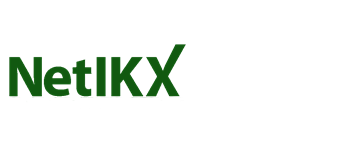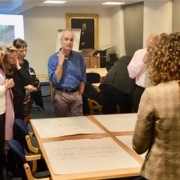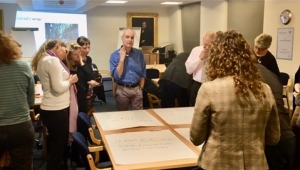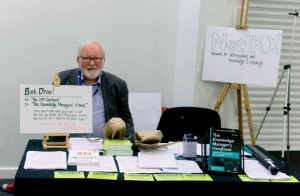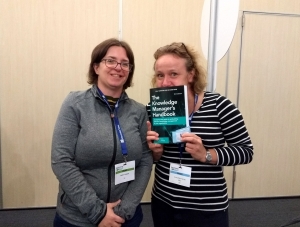Information Literacy
Account by Conrad Taylor of a NetIKX meeting with Stéphane Goldstein and Geoff Walton of the CILIP Information Literacy Group — 30 May 2019.
I must preface this account of the May 2019 NetIKX seminar with a confession: I really hate the term ‘information literacy’ and can hardly bear typing the phrase without quote marks around it! I shall explain at the end of this report why I think the term is wrong and has negative connotations and consequences. In conversation with our speakers, I found that they largely agree with me – but in English, the term has stuck. I promise I’ll hold off the quote marks until I get to my postscript…
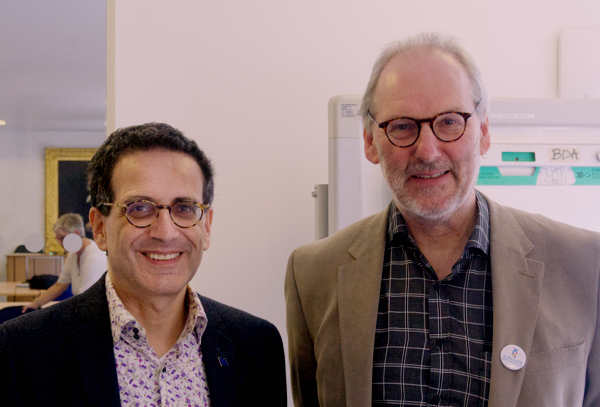
Stéphabe Goldstein and Geoff Walton
Our two ILG speakers, Stéphane Goldstein (left) and Geoff Walton (right).
Stéphane Goldstein: How CILIP redefined Information Literacy
We had two excellent speakers, Stéphane Goldstein and Geoff Walton. Stéphane led by establishing the background and explaining CILIP’s revised definition of Information Literacy, and Geoff reported a couple of practical research projects with young people.
Stéphane is an independent research consultant, with a strong interest in information and digital literacy. He acknowledged that those are contested terms, and he’d address that. With Geoff he’s been actively involved in CILIP’s Information Literacy Group (henceforth, ‘ILG’), one of 20 or so CILIP Special Interest Groups. His role in ILG is as its advocacy and outreach officer.
First he would tell us how ILG has developed its approach, and produced a new definition of Information Literacy (IL) now backed by CILIP as a whole. Secondly, he would tell us about recent political developments promoting IL and associated ‘literacies’, as important societal and public policy issues.
CILIP definition document
The CILIP definition of Information Literacy, as published in 2018.
About 15 years ago, CILIP developed its first definition of Information Literacy. This focused on knowing when and why you need information, where to find it, how to evaluate it and use it, and how to communicate it in an ethical way. At that time, the definition of IL (a term which had originated in the USA) was strongly articulated around academic skills and the work of academic librarians, even though the ideas had potential relevance to many other contexts. Information literacy at this time was defined by CILIP in terms of skill-sets, such as in searching, interpretation, and information-handling.
That older definition still has quite a lot of traction, but CILIP found it necessary to move on. For one thing, it’s now thought relevant to look at IL in other workplace environments.
In 2016, ILG began redefining IL. There was a lengthy consultative process, in several stages, and a draft definition was presented at the Librarians and Information Literacy annual conference, LILAC, in Nottingham in 2017 (see https://www.lilacconference.com/lilac-archive/lilac-2017-1). The draft was formally endorsed by CILIP at the end of 2017, and the new definition officially launched at LILAC 2018.
Stéphane had a few printed copies of the document with him, but it is readily available in PDF form on the CILIP Web site.
Defining IL
So what is different about the new definition? It is more complex than the old one, because of the need to apply the concepts to more contexts and situations. To keep it manageable, it is split into four parts. The headline definition – ‘Information literacy is the ability to think critically and make balanced judgements about any information we find and use’ – is designed to be ‘bite-sized’, and then gets fleshed out and exemplified.
The second part of the document sets things in a broader context. It talks about how IL relates to other ‘literacies’ such as ‘digital literacy’ and ‘media literacy’; and points out that IL is not just a bag of skills, but also concerns how those skills are applied. It describes the competencies, the knowledge, the confidence in applying IL in different contexts. The core of the definition is then related to five principal contexts for IL.
Conrad asked if definitions of all these derived ‘literacies’ are predicated on some foundational definition of what ‘literacy’ means, and Stéphane said — No. Indeed over the years, one of the problems that IL practitioners have had in getting the idea across is that the use of the term ‘literacy’ tends to throw up blockages to communication and comprehension. ‘Basic literacy’ of course is widely understood to mean the ability to read and to write, and perhaps to perform basic arithmetic tasks. Stéphane has heard people say that to use the ‘literacy’ word in relation to information-handling might be experienced as pejorative or counter-productive, in effect labelling some people as ‘illiterate’.
In some other languages, the concepts behind IL are labelled without reference to literacy – in French, it is ‘information mastery’ (la métrise à l’information). In Germany, they speak of Informationskompetenz (‘information competence’). In the English-speaking world, IL is the term we are stuck with for historical reasons – it’s how the concept was labelled in the USA when it emerged in 1974.
Contexts of IL application
The new IL definition refer to five sorts of lifelong situations:
Everyday life
Citizenship
Education
Workplace
Health
Everyday life: CILIP says that IL has relevance to all of us, in many situations, throughout our lives. For example, it could be about knowing how to use the Internet for day-to-day transactions, such as online banking or shopping. It’s often assumed that people know how to do these things, but Stéphane reminded us that perhaps 20–25% of people lack confidence when faced with dealing with information online. Nor is there adequate access to training in these skills, either in schools or for adults.
Citizenship: These days we are beset with information of poor or dubious quality; misinformation and disinformation affect how we step up to our political responsibilities. There are IL skills involved in finding our way through the mazes of argument and alleged evidence in such matters as Brexit, climate change and so on. Judiciously picking through evidence and assertions are vital to the future of society – democratic societies in particular.
Education: This is the context where the original IL definition was at its strongest. Now we recognise it is important not just in Higher Education, but at all stages of the education cycle. ILG is concerned that school education does not teach these competencies adequately, but haphazardly, unless you are in the minority studying for the International Baccalaureat, or doing EPQs (Extended Project Qualifications, as Geoff would later explain).
If you lack prior experience in validating information, and bump into these issues for the first time at age 18 when you go to University (in the UK, about 40% of young people) — well, that’s rather too late, Stéphane thinks. There are also contexts for IL in lifelong education.
Workplace: In work settings, a lot of information needs to be dealt with, but it’s different from academic information. A lot of workplace information is vested in knowledge that colleagues have – also associates, even competitors. Working in teams presupposes an ability to exchange information effectively. Stéphane asked, how does IL skill contribute to a person’s employability?
Health: ‘Health literacy’ is increasingly important. With the NHS under pressure, people are expected to self-diagnose; but how you can find and evaluate credible information sources?
The CILIP team focused onto these five contexts as examples to keep the list manageable, but of course there are other contexts too.
The role of information professionals
The fourth and final part of the CILIP statement looks at the role ‘information professionals’ may have in helping to promote and teach and help citizens develop an understanding of IL. (In my postscript below I note that librarians tend to have a limited and one-sided notion of just who counts as an ‘information professional’.)
There have been savage cutbacks in the public library and school library sectors; and these environments are being deprofessionalised. What guiding role can be played by remaining qualified librarians, by library assistants, and by library volunteers? How can non-qualified library workers be helped to develop their appreciation of IL, to help them play a role as advocates? A definition framed around broader concepts might help school and public librarians in this task.
Stéphane thinks this redefinition is well timed, given contemporary concerns about the role in public life of disinformation. Fundamental democratic principles, which needs a level of trust between citizens and politicians and experts, are being undermined by discourses framed around flaky information. IL is one of the tools that can be of use here, though it is not the only tool.
In Stéphane’s view, the distinctions between information, digital, media literacy and so on are not that important. With digital literacy and media literacy in particular, there is a lot of overlap these days, as more media is delivered digitally. And we should admit that the term ‘information literacy’ has little currency in public discourse: it is used chiefly by librarians.
Recent illustrative developments in the policy sphere
CILIP definition document
A Parliamentary enquiry by the Digital Culture, Media and Sport Committee, looking into ‘Disinformation and “fake news”’, reported in February 2019 after 18 months of deliberation (read more and download it from here). Facebook in particular was subjected by the Committee to a great deal of criticism.
[Conrad notes — in contrast to the lambasting that Committee handed out to the social media platforms, very little was said about the disinformation and bias in the national British press and broadcasters…]
There is a chapter about ‘digital literacy’ in the Report, which says that ‘children, young adults and adults – all users if digital media – need to be equipped in general with sufficient digital literacy to be able to understand content on the Internet, and to work out what is accurate or trustworthy, and what is not.’
The Select Committee made a recommendation that ‘digital literacy should be the fourth pillar of education, alongside reading, reading and maths’. They called on the DCMS to co-ordinate with the Department for Education in highlighting proposals to include digital literacy as part of the physical, social, health and economic curriculum (PSHE). The Government, however, rejected this recommendation, claiming they are doing it already (they are not). CILIP went to talk to DfE in Spring 2019, and were told that there would be no review of the school curriculum before the next Parliament.
The Cairncross Review was commissioned to look at the future of the UK news industry, and reported at about the same time as the other DCMS committee. Amongst its observations were that online platforms’ handling of news should be placed under regulatory supervision, and it introduced the concept of ‘public interest news’. [Download the report]
That report uses the terms ‘media literacy’ and ‘critical literacy’ and echoes the Select Committee’s recommendations in calling for these skills to be promoted. It called of the Government to develop a ‘media literacy strategy’ and to identify gaps in provision and engage with all stakeholders. That recommendation has been adopted by government. This initiative came from the world of journalism, not the world of librarianship.
In April 2019 a White Paper on ‘Online Harms’ was published to initiate a consultation which has now closed (see https://www.gov.uk/government/consultations/online-harms-white-paper). The paper set out the government’s plans for a package of measures to keep UK users safe online, especially users defined as vulnerable.
The government uses a broad definition of what it means by ‘online harms’ — child sexual exploitation and abuse, terrorist content, content illegally uploaded from prisons, online sale of drugs, cyber-bullying, [encouraging] self-harm and suicide, under-age sharing of sexual imagery, and finally disinformation and manipulation. It also talks about online abuse of public figures.
Primarily the government’s White Paper aims to strengthen the regulatory environment, but it does have a nine-page sub-chapter on ways of empowering users. That section is mostly about education, and says, ‘Media and digital literacy can equip users with the skills they need to spot dangers online, to critically appraise information, and to take steps to keep themselves and others safe online. It also has wider benefits, including for the functioning of democracy, by giving users a better understanding of online content and enabling them to distinguish between facts and opinion.’
Like the Cairncross Review, the White Paper envisages the development of a National Media Literacy Strategy – which will probably take a while to evolve. It explicitly identifies librarians as partners in the development of that strategy – so perhaps CILIP’s approaches to government have not been in vain.
Stéphane expressed satisfaction that the White Paper recognises it as a serious problem when people are unable to distinguish between facts and opinions.
Measures on Health Literacy
At the end of 2017, NHS Health Education England and other bodies launched a Health Literacy Toolkit, ‘to help health staff tackle the challenges caused by low levels of health literacy, and improve health outcomes’. As the news release stated, ‘According to the Royal College of General Practitioners, health information is too complex for more than 60% of working age adults to understand, which means that they are unable to effectively understand and use health information.’ Interestingly, the toolkit aims to improve the ability of health professionals to explain health issues effectively. It was piloted in the East Midlands.
(Unfortunately, in a classic example of public sector ‘link rot’, all Health Education England URL references to the toolkit are dead-ends after just 20 months.)
IL considered in Europe
The European Commission also commissioned a report on fake news and disinformation, which offered important proposals in relation to media and information literacy. Some of the proposals are again in the educational realm, and it says ‘Media and information literacy has become an essential competence, as it is the starting point for developing critical thinking and good personal practice for discourse online, and also consequently in the offline world.’
The recommendations included better recognition of media and information literacy as key subjects for school curricula across Europe. The report also recommended that teacher training colleges incorporate media and information literacy as part of teachers’ own training and life-long learning.
Interventions in the UK (and Ireland)
Many organisations in the UK are showing an interest in IL, and the ILG has had dealings with many of them. Within DCMS there is the clumsily-named ‘Counter Online Manipulation of Security and Online Harms Directorate’ – a rather poorly resourced section, co-ordinating government policy on disinformation.
Then there is Ofcom, the communications regulator, part of its role being ‘to chart public perceptions and understanding of media literacy in the UK.’ Their understanding of media literacy is rather broad, and relates to the media environment.
The National Literacy Trust is a charity, chiefly interested in promoting basic literacy (reading and writing), but also has a set of resources on critical literacy, fake news and disinformation. You can read more and create a login to access free teaching resources, from here.
‘Newswise’ is a pilot project developed under the auspices of The Guardian newspaper, with Google funding. It helps to develop news literacy amongst primary school children. (See June 2018 Guardian article about Newswise.)
Ireland is interesting: the >Media Literacy Ireland initiative is backed by the Broadcasting Authority of Ireland (https://www.bemediasmart.ie/about) and it has brought some 40 key players together, including the national broadcaster RTÉ, the Press Council of Ireland, Sky, Facebook and Google, and the Library Association of Ireland. Stéphane thinks that it helps that Ireland’s population is only five million; in a country with 65m, it could be much more difficult.
Another challenge which Stéphane noted is, with many organisations showing an interest in these issues, how to ensure join-up and concerted activity? Internationally, UNESCO does some work in this area but it doesn’t have a lot of influence. The EU has shown an interest, but has no statutory powers in this area; its activity has been limited to research and reports.
Geoff Walton: improving information discernment
Geoff reported on research work funded by the Information Literacy Group and the British Academy. This work is interesting both for its cross-disciplinary approach and scientific components, and its trialling of practical educational interventions. The team included Jamie Barker at Loughborough University, Matt Pointon at Northumbria University, and Martin Turner and Andy Wilkinson from Staffordshire University. Geoff himself is a senior lecturer in the Department of Information and Communication at Manchester Metropolitan University.
Geoff reminded us again of the CILIP 2018 definition of Information Literacy as ‘the ability to think critically and make balanced judgements about any information we find and use’, which ‘empowers us as citizens to develop informed views and to engage fully with society.’ Geoff and colleagues focused on the bit about making informed judgements about information that was presented to the test subjects.
He also said that rather than using the term ‘balanced’, he’d prefer to say ‘well calibrated’. There seems to be a problem with the idea of balance — note how badly the BBC has misjudged the practical consequences of fetishising ‘balance’ between opposed views, notably on the Today programme, and Question Time.
The concept of information discernment
Some people are good at making well-calibrated judgements about information, and others do it poorly. The studies considered these as gradations in information discernment. The differences affect people’s responses when exposed to mis-information – emotionally, cognitively and even physiologically.
Hy-Brasil
Many maps showed the presumed location of the (mythical) island of ‘Hy-Brasil’ west or Ireland — though they often disagreed about just where it was!
The research explored this in a case study with young people 18–21 years of age. Further research with a cohort of young people aged 16–17 also found that there are ways in which we can help the ‘low discerners’ to become ‘high discerners’, with the right kind of training. Geoff would report on both.
Dis-information and mis-information are nothing new. Geoff referred to a persistent myth of the existence of a fog-shrouded island west of Ireland known as ‘Hy-Brasil’ (possibly from Irish Uí Breasail). Belief in this inspired several expeditions, and the island was marked on maps from 1325 onwards, even as late as 1865. Geoff also referred to the contemporary nutritionist Gillian McKeith, author of ‘You Are What You Eat’, and her string of bogus qualifications (see Wikipedia: the tale of how scientist Ben Goldacre obtained one of the same diplomas for his dead cat will amuse you).
Sometimes the issue is about how information is presented. Geoff referred to a BBC News report in the 1960s about a pay dispute at Monkwearmouth Pit near Sunderland, where his dad was a miner. The BBC claimed miners were taking home £20 a week. Geoff’s dad was furious at this deception: he was taking home just £15 a week. What the BBC had done was to take an average from the top to the bottom of the pay scale.
Characteristics of high information discerners — people who tend to exhibit high levels of information discernment also display these characteristics:
they are curious about the world
they are sceptical about information presented to them by search engines
they will consult more than one information source [deliberately doing so is sometimes called ‘triangulation’, with reference to the practices of land surveying]
They recognise that it is important to check the credentials of the author or other source
if they encounter contradictory information, they tend to consider it also, rather than ignore it
they display higher levels of attention to information, as shown in the eye-tracking elements of the research
In contrast, people who exhibit low levels of information discernment are significantly less likely to be aware of these issues, and are generally inattentive to the detail of information they encounter.
It’s in the blood
Geoff’s perceptions around these issues were widened by a chance conversation with some Manchester colleagues in the field of the psychology of sport and exercise. These researchers are interested in how people deal with stress, and they operate a model of challenge and threat. This then reminded Geoff of an information behaviour model proposed by Tom Wilson in the Journal of Documentation in 1999 (‘Models in information behaviour research’), in which he identifies a role for the psychological stress/coping mechanism. Out of this encounter, an interdisciplinary twist to the research was developed.
In a stressful situation, some people regard the stressor as a challenge and respond to it adaptively, but if you experience it as a threat, your response is likely to be maladaptive and unhelpful to yourself. As Geoff put it, standing before the NetIKX audience, he felt inspired to rise to the challenge, but if his response were maladaptive his throat might tighten, he might panic and fluff his lines.
Physiologically, any positive response to stress goes along with a measurable dilation (widening) of the blood vessels, especially the arteries and major veins, increasing blood flow, including of course to the brain. But in the case of maladaptive responses, the experience of threat results in the opposite, vasoconstriction, which restricts blood flow.
The research team therefore investigated whether there was a link between their ‘information discernment’ model, and measurable physiological reactions to misinformation.
The lab space
The research team set up a laboratory space with various instruments. One side was equipped with a ‘Finometer® PRO’, a non-invasive monitoring device which puts a small pressure cuff around the test subject’s finger and uses transmitted light to examine blood flow on a continuous beat-to-beat basis, reporting on blood pressure, pulse rate etc. (See http://www.finapres.com/Products/Finometer-PRO). The other side of the lab featured an eye-tracking system, which Geoff didn’t describe in detail, but he later showed us the kind of ‘attention heat map’ display it produces.
The team got their subjects to do various tasks. One task was a word-search which was actually impossible to complete satisfactorily (this reminds me of the famous Star Trek Kobiyashi Maru no-win scenario, a test of character). Obviously, not having a solution generates some mild stress. They also told the test subjects that they were helping another student, referred to as ‘the confederate’, to win £100 (this was a fib). Some participants were additionally told that the ‘confederate’ they were thus helping was a person of extreme religious views (again, not true, but a way of winding up the stress levels).
With the test completed, the test subjects were then taken through a PANAS self-reporting mood-assessing questionnaire (Positive And Negative Affect Schedule), and then the subjects were fully and honestly debriefed.
Results: There does seem to be a relationship between the level of information discernment and how subjects reacted to stress. Those whom the team classified as exhibiting high information discernment tended to react to stress as a ‘challenge’, rather than treating it like a threat to their well-being. They exhibited more efficient blood flow, and a healthier, better-adapted heart response. Also – this came as something of a surprise to the team – high information discernment individuals responded with more positive emotions in the PANAS assessment.
The information search task
Heatmap
Two of the heat maps generated by the eye-tracking equipment, showing how much attention different participants gave to different parts of the information display. That on the left was measured from someone the team considered to exhibit the characteristics of ‘high information discerner’, the one on the right, from a ‘low information discerner’.
Another task for the test subjects was to look at a page of information, made from text and data graphics sourced from The Guardian, headed ‘Religious extremism main cause of terrorism, according to report’ (it’s a rearrangement of material from a November 2014 article).
Geoff displayed a couple of ‘heat maps’ that were generated from the eye tracking monitor system, showing the extent to which different parts of the ‘page’ received the most attention from different participants: see image. The left example belonged to a ‘high discerner’, and the other to a ‘low discerner’. Admittedly, the two examples Geoff showed us were at the extremes of those observed.
Delving deeper, Geoff said that the ‘high discerner’s’ saccadic movements (this means, the sequential leaps between eye-fixation points) were measurably more ordered; this person also extensively examined the graphical components, which were completely ignored by the low discerner.
Conrad commented that there are particular skills involved in interpreting data graphics, which could make it a complicating factor in this study. It may be that the individual whose heat-map was displayed on the right does not have those skills, and therefore ignored the data graphics. Of course, lack of that skill might correlate with ‘low information discernment capability’ generally, and it doesn’t seem that unlikely, but it’s not a foregone conclusion.
From this part of the study, the research team concluded:
People with low information discernment capabilities are more likely to experience negative physical and emotional reactions [as tested by the Finometer and the PANAS review] when looking for information. This is exacerbated if the information they are presented with is contradictory.
‘Low discerners’ are less likely to attend to detail, and are unlikely to check the sources of information, or the credentials of the writer or other person telling them the information.
Can we help develop information discernment?
If it possible to move low information discerners to become high information discerners? The good news is, the team found that they could, and they offer four rules of thumb:
In such training, you need to match a person’s context as closely as you can, such as what people are typically doing and trying to find out. In other words, ‘generic’ forms of training won’t work.
The training needs to be informal and conversational.
The training should be collaborative.
It should be practical, not theoretical.
Geoff passed around some copies of materials which they prepared for the training workshop with a group of school students aged 16–17. He noted that similar results have also been recorded with first-year university students.
In this case, the subjects were given two pieces of information about smoking. One was a company Web site, the other was about research from a university. Trainees noticed things of which they were previously oblivious, such as citations and sources, and they developed an appreciation of the need to consider whether information sources are reliable.
This part of the work, funded by the British Academy, was aimed at helping a particular school deliver their Extended Project Qualification. The EPQ is an optional qualification within the National Qualifications Framework in England and Wales, taken after A-Levels, and involves producing a dissertation of about 5,000 words or some similar artefact, plus documentation showing research and thinking processes. (It is similar to the Scottish Sixth Year Studies qualification which was available from 1968 to 2000.) The EPQ assignment is probably the first time that school students have to do something where the information has not been handed to them on a plate – they have to find it out for themselves, and it is a good introduction to what they’ll meet at university.
Teachers involved in this workshop project noted a real shift in information behaviours as a result – no longer was there a passive acceptance of information, and students started to question the credibility of sources. The only problem, said Geoff, is that they can go too far and question everything, and you have to lead them back to an understanding that there are certain facts out there!
The project conclusion is that by training low information discerners, you can help them construct their own cognitive firewalls – which is better than relying on ‘machines of loving grace’ to protect us with filters and AI algorithms. We may hope that by encouraging people to have the cognitive habits and capabilities of high information discerners, they will be less susceptible to the unsubstantiated claims which permeate the Internet, and especially social media.
Stéphane and Geoff would love to work with other groups and constituencies to help mainstream Information Literacy, and would like to hear ideas for joint events and case studies.
Discussion summaries
After a break we assembled into table groups, and each table discussed a different aspect of the issue. Lissi Corfield then called on the groups to report back to a brief plenary session, and I report some of the points below:
On trusting information sources: one participant remarked that her window-cleaner had said that he got all his knowledge of what was going on in the world from Facebook. Initially that thought might inspire horror; but on the other hand, we’ve always trusted people we know as intermediates; is this so different?
IL in the workplace: the table considering this topic agreed that the tools and methods described by Geoff (and used in schools) could also find application in the workplace. But it would be lovely not to have to teach newcomers coming in from school and university about IL – they should have learned it already!
Logic and education: Another table, from which Dion Lindsay reported, thought that Logic, currently taught in the first year of university Philosophy courses, should have a place in secondary school education, as a foundation for thought. (I commented, ‘Bring back the mediaeval curriculum!’, in which Grammar, Logic and Rhetoric were the three foundational liberal arts subjects – the trivium.)
Self-awareness: a fourth table group commented that there is value in helping people to be more aware of, and critical of, their own thought processes.
Awareness of how search engines work – for example, why Google searches result in a particular ranking order of results – should help to foster a more critical approach to this information gateway.
PostScript: my discomforts with the ‘IL’ term
Origins of the ‘information literacy’ term
The Zurkowski document
Paul Zurkowsky’s 1974 paper — where the term ‘information literacy’ was coined.
It was from Geoff that I learned that the term ‘information literacy’ was coined by Paul G. Zurkowski in 1974, in a report for the [U.S.] National Commission on Libraries and Information Science.
Indeed, Geoff was so kind as to email me a copy of that paper, as a PDF of a scanned typescript — a section of the cover page is shown right. In the USA, the term seems to have been picked up by people involved in Library and Information Studies (LIS) and in educational technology.
I personally first encountered the IL term in January 2003, at a workshop hosted by the British Computer Society’s Developing Countries Specialist Group, in the run-up to the UN World Summit on the Information Society. The WSIS secretariat had been pushing the idea of ‘Information Literacy’. John Lindsay of Kingston University chaired the meeting.
A temple-like model of ‘Seven Pillars of Information Literacy’ had been dreamed up four years earlier by the Society of College, National and University Libraries (SCONUL), and two LIS lecturers from London Metropolitan University were promoting it. A full account of that workshop is available as PDF.>
SCONUL model of IL: seven pillars
SCONUL’s ‘Seven Pillars of Information Literacy’, redrawn by Conrad Taylor.
I took an immediate dislike to the term. Everyone agrees that true literacy, the ability to read and to write, is a fundamental skill and a gateway to learning; and this smelt to me like a sly attempt to imply that librarians, with their information retrieval and analysis skills, were as valuable to society as teachers.
In September 2003 I ran a conference called Explanatory and Instructional Graphics and Visual Information Literacy. My preparatory paper ‘New kinds of literacy, and the world of visual information’ is available from this link.
Also, proper literacy requires skills in consumption (reading) and production (writing), but in my experience librarians consistently don’t say much to recognise the skills used by those making information products: writers and illustrators, graphic designers, documentary film producers, encyclopaedists and so on.
There is a term ‘visual literacy’ as featured since 1989 in the journal of the same name and the International Visual Literacy Association, but I am prepared to cut that use of the L-word more slack because IVLA and the journal are concerned about design as well as consumption.
As for the implication that Stéphane referred to, that someone having difficulty in finding and making critical judgements about information is in effect being shamed as ‘illiterate’, I confess that objection hadn’t occurred to me.
Critique the object/system, not the hapless user?
In the field of Information and Communication Design, where I have been a practitioner for 30+ years, our professional approach to failures of communication or information discovery is not to default to blaming the reader/viewer/user, but to suspect that the information artefact or system might not have been designed very well. It’s just not on to react to such problems by claiming the public is ‘information illiterate’, when the problem is your illiterate inability to communicate clearly.
Some weeks later, while at the ISKO UK conference, it also occurred to me that people who work to improve the way information sources are organised, and work on improving how they are documented and accessed, share this attitude with Information Designers. They also do not accuse people of ‘illiteracy’ – they address the lack of coherence in the information. Is there something about librarian culture that resists deconstructing and critiquing information products and systems, and leaves them inviolate on a pedestal?
Anyway, I’ll draw my small tirade to a close! I do agree that there is A Problem, and I largely agree with Stéphane and Geoff about the shape of that problem. I shall continue to place quote marks around ‘information literacy’ and contest the use of the term. I like the German alternative that Stéphane mentioned, Informationskompetenz. I think I shall refer to ‘information handling competences’ in the plural, as my Preferred Term.
— Conrad Taylor, July 2019
